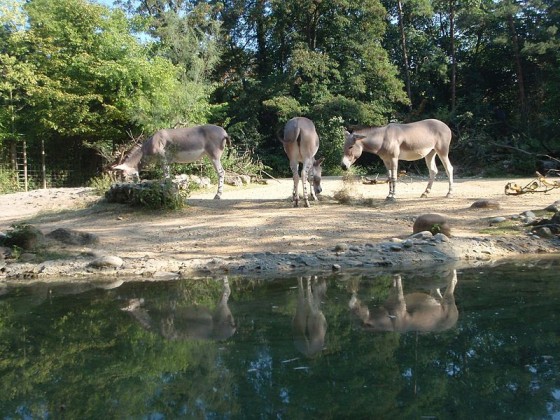 African wild asses in a Basel Switzerland zoo. Perhaps the only hope for their survival of this animal which once roamed North Africa.
African wild asses in a Basel Switzerland zoo. Perhaps the only hope for their survival of this animal which once roamed North Africa.
Wild animals in North Africa and which are/were also found in the Middle East are threatened: there is the Arabian Oryx,a species of leopards and even baby crocodiles. One particular hoofed mammal, the African Wild Ass (Equus asinus), which zoologists say is the ancestor of the domestic donkey, is now considered to be critically endangered and down to less than 600 of its kind in the wild, although a few hundred now live in captivity.
 Somali Wild Ass in natural habitat. Photo Brent Huffman
Somali Wild Ass in natural habitat. Photo Brent Huffman
Once fairly numerous in parts of North Africa, including Egypt, Sudan and Libya, this creature, which resembles a zebra without most of its stripes (except for a few found on the legs) the Wild Ass is now restricted to a few areas of Somalia, Eritrea and Ethiopia.
These areas are not very inhabitable to most animal species, as well as human beings, due to continues warfare and civil strife. This region is also in the midst of one of the most critical droughts in the last half century. Also known as the Somalian Wild Ass, it is often hunted for food as well as for use in “traditional medicine” in Ethiopia and Somalia.
A small herd of Somali Wild Asses, as well as a herd of Arabian Oryx are now living in the Yotvata Hai Bar wildlife reserve in Israeli’s Arava desert. The aim of reserves like Hai Bar, and others in countries like Jordan, the United Arab Emirates, and Saudi Arabia are to try to reintroduce animal species back into former natural habitats where they once lived but later became extinct.
In the case of Saudi Arabia, a number of wild animal species even starved to death when a fence built to “protect” them actually prevented animals like the Oryx from access to their natural food supply, resulting in the deaths of hundreds of Oryx and sand gazelles during a period between 1991 and 2008 .
Even though some success has been made in breeding these animals in a more or less natural habitat, the animal’s fortunes in the wild are becoming more critical. The way things are heading, it won’t be long before animals like the African Wild Ass and Arabian Oryx will no longer exist in the wild.
Wild Ass photo via Brent Huffman:
Read more on wild animals at risk in the Middle East:
Thai Migrant Workers Poach Wild Animals for Food in Israel
Protective Fence Leads to Mass Starvation of Saudi Wildlife
Live Baby Leopard Found in Suitcase En Route to Dubai
Baby Croc Harry Dies in Dubai: Another Animal Rights Abuse Case?


